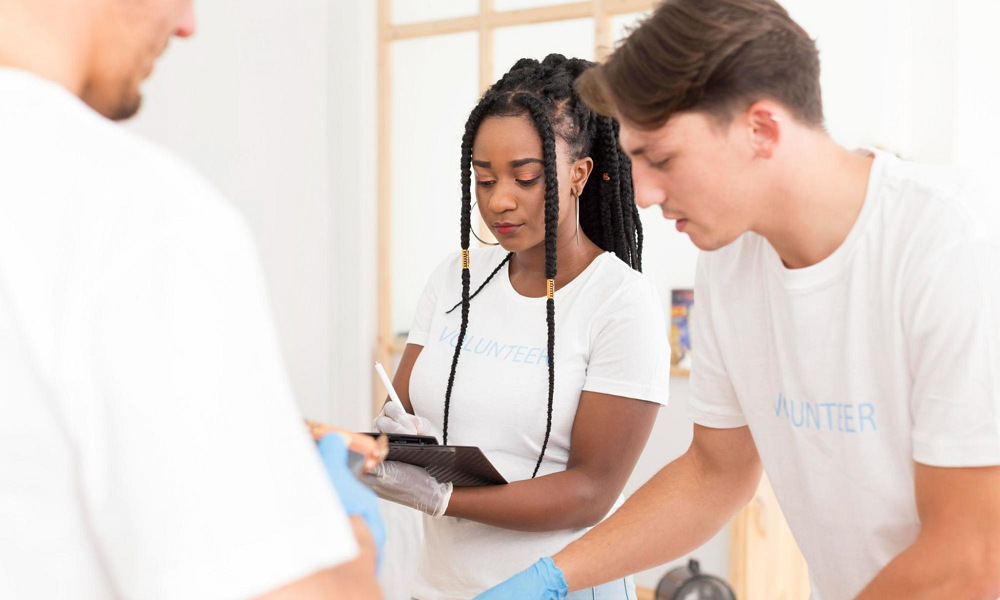Reviews
The Importance of Clinical Training in Healthcare Education

Clinical training forms the backbone of healthcare education, serving as a bridge between academic theory and real-world practice. For students pursuing careers in medicine, nursing, physical therapy, and other health-related fields, this hands-on experience is critical for building competency, confidence, and compassion. It provides an opportunity to apply classroom knowledge, develop technical skills, and interact with patients in dynamic healthcare environments.
This post delves into the importance of clinical training, the components of effective programs, and the ways it shapes the future of healthcare professionals.
The Role of Clinical Training in Healthcare
Clinical training is an immersive process that enables students to experience the realities of patient care under the guidance of seasoned professionals. It is more than just acquiring technical skills—it’s about learning how to think critically, communicate effectively, and act ethically in challenging situations.
For many students, the clinical setting is where they first understand the full scope of their chosen profession. They witness the interplay of science, empathy, and teamwork in delivering quality care, which often reinforces their commitment to the field.
Core Objectives of Clinical Training
An effective clinical training program should achieve several key objectives:
1. Skill Development
Students gain hands-on experience in performing procedures, using medical equipment, and interpreting diagnostic data. Whether it’s inserting an IV, conducting a physical exam, or utilizing imaging technology, clinical training helps students refine their technical abilities.
2. Critical Thinking
Healthcare is a field where no two cases are exactly alike. Clinical training challenges students to think critically and adapt to complex, often unpredictable situations. This includes analyzing patient data, making informed decisions, and troubleshooting when complications arise.
3. Interpersonal Communication
Working with patients and collaborating with healthcare teams requires excellent communication skills. Clinical training provides students with opportunities to practice explaining diagnoses, discussing treatment options, and offering emotional support to patients and families.
4. Professionalism and Ethics
Clinical settings introduce students to the ethical dilemmas and professional standards of healthcare. They learn to navigate sensitive issues, such as end-of-life care and patient confidentiality, while upholding ethical principles.
5. Confidence Building
Repeated exposure to clinical scenarios helps students gain confidence in their abilities. This confidence is essential not only for performing tasks but also for earning the trust of patients and colleagues.
Educational Pathways to Clinical Training
Before diving into the immersive experience of clinical training, healthcare professionals must first complete rigorous academic programs that lay the groundwork for their future careers. These educational pathways are essential for equipping students with the knowledge, skills, and foundational understanding required to excel in clinical settings.
1. Undergraduate Education
For most healthcare professions, the journey begins with a bachelor’s degree. Many students choose majors in fields like biology, kinesiology, or health sciences to fulfill prerequisites for advanced programs. Undergraduate coursework typically includes subjects such as anatomy, physiology, chemistry, and psychology, all of which are critical for understanding patient care. Additionally, leveraging resources like Microsoft AZ-104 Practice Test Dumps can help students strengthen their foundational knowledge in cloud-based systems, which are becoming increasingly relevant in healthcare technology.
2. Graduate and Professional Degrees
After completing an undergraduate degree, aspiring healthcare professionals must pursue specialized graduate education. The type of degree required varies by profession:
- Medical School: For physicians, earning a Doctor of Medicine (MD) or Doctor of Osteopathic Medicine (DO) degree is essential.
- Nursing Programs: Advanced practice nurses, such as nurse practitioners, often pursue a Master of Science in Nursing (MSN) or Doctor of Nursing Practice (DNP).
- Physical Therapy: Physical therapists must complete a Doctor of Physical Therapy program (DPT), which includes both classroom instruction and hands-on clinical training. These programs emphasize biomechanics, rehabilitation techniques, and patient interaction, preparing graduates to excel in diverse clinical environments.
- Other Allied Health Professions: Fields like occupational therapy, speech-language pathology, and physician assisting also require advanced degrees, typically at the master’s or doctoral level.
3. Licensure and Certification
Once formal education is complete, graduates must obtain licensure or certification to practice. This process often includes passing national exams, meeting state-specific requirements, and completing continuing education to maintain credentials.
The educational journey is rigorous but vital for ensuring healthcare professionals are well-prepared for the complexities of clinical training and patient care. Programs like the Doctor of Physical Therapy program are particularly noteworthy for their emphasis on blending academic excellence with practical experience, setting the stage for success in both clinical and non-clinical roles.
Education not only provides the technical knowledge needed for clinical training but also fosters a commitment to lifelong learning. This dedication to growth and development is a hallmark of exceptional healthcare professionals.
Components of Effective Clinical Training
A well-rounded clinical training program includes various elements designed to prepare students comprehensively.
1. Simulation-Based Learning
Before entering clinical settings, many programs use simulation labs to help students practice procedures in a controlled environment. High-fidelity mannequins, virtual reality platforms, and standardized patient actors allow students to hone their skills without the risk of harming actual patients.
2. Supervised Clinical Rotations
Clinical rotations place students in real-world healthcare settings, such as hospitals, clinics, and long-term care facilities. Under the supervision of licensed practitioners, students gain experience in diagnosing and treating patients across diverse populations and conditions.
3. Interdisciplinary Training
Healthcare delivery is a team effort. Interdisciplinary training exposes students to collaborative practices with peers from other specialties, such as nursing, pharmacy, and social work. This fosters mutual respect and understanding, which are critical for effective teamwork.
4. Regular Feedback and Assessment
Constructive feedback from supervisors and peers is an integral part of clinical training. Assessments based on performance, communication, and professionalism help students identify areas for improvement and track their progress.
5. Cultural Competency Education
Diverse patient populations require healthcare professionals to be culturally sensitive and aware. Clinical training often includes education on addressing language barriers, respecting cultural practices, and delivering equitable care.
Challenges in Clinical Training
While clinical training is invaluable, it comes with challenges for both students and educators.
1. Balancing Academic and Clinical Responsibilities
Healthcare students often juggle rigorous coursework with demanding clinical schedules. This can lead to stress and burnout, making time management and self-care essential.
2. High-Stakes Learning Environment
Mistakes in clinical settings can have serious consequences, adding pressure to students. While supervision mitigates risks, the fear of errors can impact confidence and performance.
3. Limited Placement Opportunities
Securing clinical placements can be competitive, especially in high-demand areas like urban hospitals. This can limit students’ exposure to certain specialties or populations.
4. Adapting to Diverse Clinical Settings
Every healthcare facility operates differently, requiring students to quickly adapt to new workflows, policies, and technologies. This variability can be both a challenge and a learning opportunity.
Innovations in Clinical Training
Advancements in technology and educational practices have led to innovative approaches in clinical training.
1. Telehealth Training
With the rise of telehealth, many programs now include training on virtual patient consultations. This prepares students to provide care remotely, a skill that is increasingly relevant in modern healthcare.
2. AI-Powered Simulations
Artificial intelligence is enhancing simulation-based learning by creating more realistic scenarios. AI-driven tools can provide personalized feedback and adapt scenarios to mimic real-world complexities.
3. Global Health Rotations
Some programs offer opportunities for students to complete clinical rotations in international settings. These experiences expose students to global health challenges, diverse healthcare systems, and cross-cultural practices.
4. Peer-Assisted Learning
Peer-assisted learning models encourage students to teach and learn from one another. This fosters a collaborative spirit and helps students reinforce their knowledge by explaining concepts to peers.
The Impact of Clinical Training on Healthcare Careers
The lessons learned during clinical training extend far beyond the classroom, shaping students into competent and compassionate professionals. For many, these experiences are transformative, solidifying their career aspirations and defining their approach to patient care.
1. Enhanced Employability
Employers value candidates with extensive clinical experience, as it demonstrates readiness for real-world practice. Strong performance during clinical rotations can also lead to job offers from placement sites.
2. Lifelong Learning Skills
Clinical training instills a habit of continuous learning, as students must stay updated on new techniques, technologies, and evidence-based practices throughout their careers.
3. Professional Networks
During clinical placements, students build relationships with mentors, colleagues, and industry professionals. These connections can provide guidance, support, and career opportunities in the future.
Supporting Students Through Clinical Training
To ensure the success of clinical training programs, educators and institutions must prioritize student support.
1. Accessible Resources
Providing access to study materials, mental health services, and financial assistance can help students navigate the challenges of clinical training.
2. Comprehensive Orientation
A thorough orientation helps students understand the expectations, protocols, and resources available in clinical settings, reducing anxiety and enhancing preparedness.
3. Fostering Inclusivity
Creating an inclusive learning environment ensures that students from all backgrounds feel valued and supported. This includes addressing biases and promoting diversity within clinical teams.
Conclusion
Clinical training is a cornerstone of healthcare education, preparing students to meet the demands of a dynamic and challenging profession. By combining hands-on experience with mentorship and innovation, these programs ensure that future healthcare professionals are equipped to deliver exceptional care.
While the journey is demanding, the rewards are immeasurable. Clinical training not only shapes technical proficiency but also cultivates empathy, resilience, and a deep commitment to improving lives. As healthcare continues to evolve, the lessons learned in clinical settings will remain a foundation for excellence in the field.

-

 World1 week ago
World1 week agoCargo plane plunges into sea at Hong Kong airport; 2 killed
-

 Health1 week ago
Health1 week agoMexico reports new human case of H5 bird flu
-

 US News4 days ago
US News4 days agoUnwarned tornado suspected in Fort Worth as storms cause damage and power outages
-

 World2 days ago
World2 days agoU.S. Navy helicopter and fighter jet crash in South China Sea; all crew rescued
-

 Legal1 week ago
Legal1 week agoMan armed with AR-15 arrested after threats to ‘shoot up’ Atlanta airport
-

 Legal3 days ago
Legal3 days agoMultiple injured in shooting at Lincoln University in Pennsylvania
-

 World1 week ago
World1 week agoMagnitude 5.0 earthquake rattles Dominican Republic
-

 World7 days ago
World7 days agoMagnitude 6.1 earthquake strikes Ecuador–Peru border region




